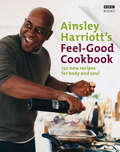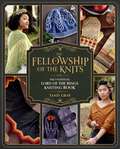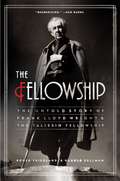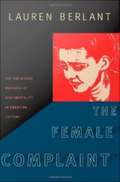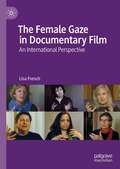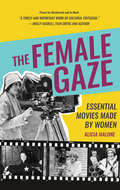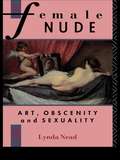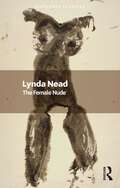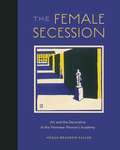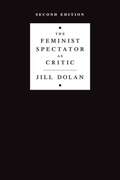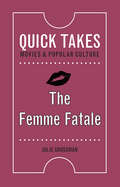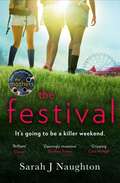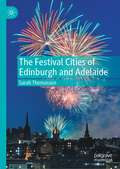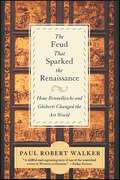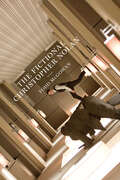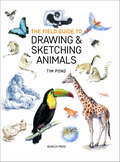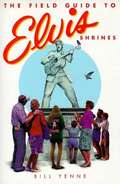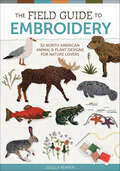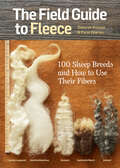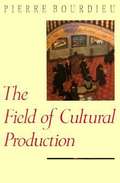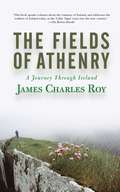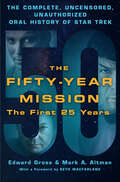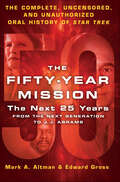- Table View
- List View
The Feel-Good Cookbook
by Ainsley HarriottFollowing the success of his most recent Friends and Family Cookbook, Ainsley is turning his culinary attention to feel-good cookery food that makes you feel great. Capturing Ainsley's enthusiasm for making cooking fun, The Feel-Good Cookbook brings us food that is good for the body and the soul: healthy, tasty and easy to prepare. 150 brand-new recipes make up a bible of deliciously simple recipes, essential for time-pressed cooks wanting fresh, flavoursome and nutritious food. Chapters range from Light Bites and Quick and Easy Suppers to Mid-week Meals and Substantial Salads, and features include handy menu spreads, store-cupboard essentials and a guide to sourcing ingredients.
The Feeling of Space
by Christopher BardtA richly illustrated exploration of humanity’s drive to shape life as a spatial project, from Plato’s time to the digital era.Place is something real, but space is generally conceived as abstract and immaterial. In The Feeling of Space, Christopher Bardt explores this damaging modern binary and traces the contradictory impulses that have dematerialized our sense of space through history: fear and wonder; a yearning for the infinite and intimate; and the need for autonomy and belonging. Using rich illustrations and examinations of art, technology, and philosophy, Bardt argues that if we can get back to first feeling space, then we can treat space as the substance that gives agency to our intersubjectivity—the exchange of conscious and unconscious thoughts we have with others. Expertly connecting ideas with clear examples from lived experiences, Bardt’s revolutionary framework will appeal to a broad readership, particularly those who are interested in the theoretical and philosophical aspects of spaces. In an age where digital media has dissolved, instead of increased, our sense of connection, The Feeling of Space shows that when we learn to experience space as a medium as real as a place, we not only see ourselves as inherently spatialized beings, but we can also rebuild the bonds that tie us together.
The Fellowship of the Knits: Lord of the Rings: The Unofficial Knitting Book
by Tanis GrayExperience the magic of knitting in the first-ever Lord of the Rings knitting guide, featuring more than 25 patterns inspired by the mythical world of Tolkien&’s Middle-earth.Knit your way across J. R. R. Tolkien&’s Middle-earth, from the Shire&’s idyllic countryside to the Elfin palaces of Rivendell, with this first-ever Lord of the Rings knitting guide. With patterns to suit your every otherworldly mood, this book includes cozy knits to languish by the fire in at Bag End, rustic outerwear to enjoy a beer and a warm bowl of stew at The Prancing Pony Inn, and elegant laces suited for the lush, peaceful valley of Rivendell.Inspired by the popular books and film adaptations—including beloved characters, locations, and natural elements––this guide features a variety of knitting techniques, like cables, lace, colorwork, brioche, and textured stitches, and it includes patterns for apparel, accessories, and home décor for every skill level. From the Hobbits&’ warm, rustic knits and the Dwarves&’ rugged armor to the intricate, lacy garments of the Elves of Rivendell, there&’s a pattern to suit everyone in your life.With detailed instructions and stunning full-color photography, knit yourself an Elf Maiden Cloak, Second Breakfast Socks and Mittens, an Elven Bread Shawl, a Dwarf Battle Helmet, a One Ring to Warm Them All Scarf, a Precioussss Doll, and more with the help of this homage to the beautiful world of The Lord of the Rings.FIRST LOTR KNITTING GUIDE: This unofficial guide is the first book made up entirely of Lord of the Rings-inspired knitting projects.OVER 25 KNITTING PROJECTS: Knit more than 25 projects for sweaters, scarves, hats, socks, gloves, blankets, and more.EVERY SKILL LEVEL: A variety of projects designed for different skill levels makes this guide ideal for beginner to advanced knitters.CLOTHING AND COSTUMES: Create classic looks from The Lord of the Rings, from an Elf Maiden Cloak to Dwarf Battle Gauntlets.ALL-STAR DESIGNERS: This knitting guide includes patterns created by some of the most popular knitting influencers on Ravelry and Instagram.DAZZLING IMAGES: Each pattern is accompanied by detailed instructions and beautiful full-color photography to help ensure success.
The Fellowship: The Untold Story of Frank Lloyd Wright & the Taliesin Fellowship
by Harold Zellman Roger Friedland“Compelling.” — Kirkus Reviews“The Fellowship both fascinates and infuriates. You can’t top the material for richness: genius, sex, spirituality, madness, money, mania.” — USA Today“[A] blockbuster…packed [with] plenty of sex and surprises. …This book has a lot of news.” — Capital Times“A mesmerizing account of the drama that compelled the great architect…to greater accomplishments…and the cost of that success.” — Ken Burns, award-winning director of The Civil War, Jazz, and Frank Lloyd Wright“Authoritative and eminently readable…uncover[s] the sometimes strange, sometimes scandalous, always tumultuous atmosphere in which Wright created his pioneering designs.” — Robert C. Twombly, author of Frank Lloyd Wright: His Life and His Architecture“This book replaces Wright the demigod with Wright the man…[A] new—and truer—picture of Frank Lloyd Wright.” — Alan Hess, author of Frank Lloyd Wright: The Houses“Sheds light on the forgotten men and women who played so important a role in bringing…[Wright’s] conceptions to reality.” — Franklin Toker, author of Fallingwater Rising“Fascinating…good history. And a ripping read.” — Architect's Newspaper“An extraordinary and disquieting tale...that captures the strange, shadowy and all-too-human world that can gather around genius.” — Mark Stevens, Pulitzer Prize-winning author of de Kooning“First to treat the Taliesin Fellowship as a whole — its origin, its workings and its inner life.” — Wall Street Journal“Just when you thought there was nothing new to be learned about the great American architect Frank Lloyd Wright, a massive, gossipy and yet compulsively readable new book proves you wrong. . . .Friedland and Zellman break new ground with dozens of firsthand interviews that illuminate the crucial role of the apprentices—and of his regl last wife, Olgivanna—in shaping the second half of the architect’s storied and controversial career.” — Chicago Sun-Times
The Female Complaint: The Unfinished Business of Sentimentality in American Culture
by Lauren BerlantThe Female Complaint is part of Lauren Berlant's groundbreaking "national sentimentality" project charting the emergence of the U. S. political sphere as an affective space of attachment and identification. In this book, Berlant chronicles the origins and conventions of the first mass-cultural "intimate public" in the United States, a "women's culture" distinguished by a view that women inevitably have something in common and are in need of a conversation that feels intimate and revelatory. As Berlant explains, "women's" books, films, and television shows enact a fantasy that a woman's life is not just her own, but an experience understood by other women, no matter how dissimilar they are. The commodified genres of intimacy, such as "chick lit," circulate among strangers, enabling insider self-help talk to flourish in an intimate public. Sentimentality and complaint are central to this commercial convention of critique; their relation to the political realm is ambivalent, as politics seems both to threaten sentimental values and to provide certain opportunities for their extension. Pairing literary criticism and historical analysis, Berlant explores the territory of this intimate public sphere through close readings of U. S. women's literary works and their stage and film adaptations. Her interpretation of Uncle Tom's Cabin and its literary descendants reaches from Harriet Beecher Stowe to Toni Morrison's Beloved, touching on Shirley Temple, James Baldwin, and The Bridges of Madison County along the way. Berlant illuminates different permutations of the women's intimate public through her readings of Edna Ferber's Show Boat; Fannie Hurst's Imitation of Life; Olive Higgins Prouty's feminist melodrama Now, Voyager; Dorothy Parker's poetry, prose, and Academy Award-winning screenplay for A Star Is Born; the Fay Weldon novel and Roseanne Barr film The Life and Loves of a She-Devil; and the queer, avant-garde film Showboat 1988-The Remake. The Female Complaint is a major contribution from a leading Americanist.
The Female Gaze in Documentary Film: An International Perspective
by Lisa FrenchThe Female Gaze in Documentary Film – an International Perspective makes a timely contribution to the recent rise in interest in the status, presence, achievements and issues for women in contemporary screen industries. It examines the works, contributions and participation of female documentary directors globally. The central preoccupation of the book is to consider what might constitute a ‘female gaze’, an inquiry that has had a long history in filmmaking, film theory and women’s art. It fills a gap in the literature which to date has not substantially examined the work of female documentary directors. Moreover, research on sex, gender and the gaze has infrequently been the subject of scholarship on documentary film, particularly in comparison to narrative film or television drama. A distinctive feature of the book is that it is based on interviews with significant female documentarians from Europe, Asia and North America.
The Female Gaze: Essential Movies Made by Women
by Alicia Malone&“An unabashed love letter to our cinema sisters . . . a treasure of delights that honors more than a hundred years of female filmmaking. Brava!&” —Rachel Feldman, film/TV director, screenwriter and activistA #1 Bestseller in Movies & Video Guides & Reviews With the success of Patty Jenkins&’s Wonder Woman and the rise of the MeToo movement, women creators in film are more important than ever. Coined in the 1970s, the term &“male gaze,&” pertains to what happens to viewers when the majority of art and entertainment has been made by the one gender perspective. So, what about the opposite?The Female Gaze comprises a list detailing the essential movies from the past and present made by women. It also features multiple mini-essays written by a variety of diverse female film critics, about a woman or a movie made by women that they love. In its pages, you&’ll discover: The accomplishments of numerous women in film such as Dorothy Arzner, Ida Lupino, Kathryn Bigelow, Lady Bird&’s Greta Gerwig and moreThe lives of these women and the struggles they faced carving a place for themselves in the film industryHow these women&’s unique voices shaped the films they made and influenced all the film world &“Once again Alicia Malone champions women filmmakers, opening the floodgates to a great new wave of female voices and creative vision. A wonderful guide to some of the best films made by women, both celebrating women directors and fueling the red-hot discussion about why we don&’t have more.&” —Maria Giese, filmmaker and activist
The Female Nude: Art, Obscenity and Sexuality
by Lynda NeadAnyone who examines the history of Western art must be struck by the prevalence of images of the female body. More than any other subject, the female nude connotes `art'. The framed image of a female body, hung on the walls of an art gallery, is an icon of Western culture, a symbol of civilization and accomplishment. But how and why did the female nude acquire this status?The Female Nude brings together, in an entirely new way, analysis of the historical tradition of the female nude and discussion of recent feminist art, and by exploring the ways in which acceptable and unacceptable images of the female body are produced and maintained, renews recent debates on high culture and pornography.The Female Nude represents the first feminist survey of the most significant subject in Western art. It reveals how the female nude is now both at the centre and at the margins of high culture. At the centre, and within art historical discourse, the female nude is seen as the visual culmination of enlightenment aesthetics; at the edge, it risks losing its repectability and spilling over into the obscene.
The Female Nude: Art, Obscenity and Sexuality (Routledge Classics)
by Lynda NeadThe history of Western art is saturated with images of the female body. Lynda Nead's The Female Nude was the first book to critically examine this phenomenon from a feminist perspective and ask: how and why did the female nude acquire this status?In a deft and engaging manner, Lynda Nead explores the ways in which acceptable and unacceptable images of the female body are produced, issues which have been reignited by current controversies around the patriarchy, objectification and pornography. Nead brilliantly illustrates the two opposing poles occupied by the female nude in the history of art; at one extreme the visual culmination of enlightenment aesthetics; at the other, spilling over into the degraded and the obscene. What both have in common, however, is the aim of containing the female body.Drawing on examples of art and artists from the classical period to the 1980s, The Female Nude paints a devastating picture of the depiction of the female body and remains as fresh and invigorating today as it was at the time of its first publication.This Routledge Classics edition includes a new Preface by the author.
The Female Secession: Art and the Decorative at the Viennese Women’s Academy
by Megan Brandow-FallerDecorative handcrafts are commonly associated with traditional femininity and unthreatening docility. However, the artists connected with interwar Vienna’s “female Secession” created craft-based artworks that may be understood as sites of feminist resistance. In this book, historian Megan Brandow-Faller tells the story of how these artists disrupted long-established boundaries by working to dislodge fixed oppositions between “art” and “craft,” “decorative” and “profound,” and “masculine” and “feminine” in art.Tracing the history of the women’s art movement in Secessionist Vienna—from its origins in 1897, at the Women’s Academy, to the Association of Austrian Women Artists and its radical offshoot, the Wiener Frauenkunst—Brandow-Faller tells the compelling story of a movement that reclaimed the stereotypes attached to the idea of Frauenkunst, or women’s art. She shows how generational struggles and diverging artistic philosophies of art, craft, and design drove the conservative and radical wings of Austria’s women’s art movement apart and explores the ways female artists and craftswomen reinterpreted and extended the Klimt Group’s ideas in the interwar years. Brandow-Faller draws a direct connection to the themes that impelled the better-known explosion of feminist art in 1970s America. In this provocative story of a Viennese modernism that never disavowed its ornamental, decorative roots, she gives careful attention to key primary sources, including photographs and reviews of early twentieth-century exhibitions and archival records of school curricula and personnel. Engagingly written and featuring more than eighty representative illustrations, The Female Secession recaptures the radical potential of what Fanny Harlfinger-Zakucka referred to as “works from women’s hands.” It will appeal to art historians working in the decorative arts and modernism as well as historians of Secession-era Vienna and gender history.
The Female Secession: Art and the Decorative at the Viennese Women’s Academy (G - Reference, Information And Interdisciplinary Subjects Ser.)
by Megan Brandow-FallerDecorative handcrafts are commonly associated with traditional femininity and unthreatening docility. However, the artists connected with interwar Vienna’s "female Secession" created craft-based artworks that may be understood as sites of feminist resistance. In this book, historian Megan Brandow-Faller tells the story of how these artists disrupted long-established boundaries by working to dislodge fixed oppositions between "art" and "craft," "decorative" and "profound," and "masculine" and "feminine" in art.Tracing the history of the women’s art movement in Secessionist Vienna—from its origins in 1897, at the Women’s Academy, to the Association of Austrian Women Artists and its radical offshoot, the Wiener Frauenkunst—Brandow-Faller tells the compelling story of a movement that reclaimed the stereotypes attached to the idea of Frauenkunst, or women’s art. She shows how generational struggles and diverging artistic philosophies of art, craft, and design drove the conservative and radical wings of Austria’s women’s art movement apart and explores the ways female artists and craftswomen reinterpreted and extended the Klimt Group’s ideas in the interwar years. Brandow-Faller draws a direct connection to the themes that impelled the better-known explosion of feminist art in 1970s America. In this provocative story of a Viennese modernism that never disavowed its ornamental, decorative roots, she gives careful attention to key primary sources, including photographs and reviews of early twentieth-century exhibitions and archival records of school curricula and personnel. Engagingly written and featuring more than eighty representative illustrations, The Female Secession recaptures the radical potential of what Fanny Harlfinger-Zakucka referred to as "works from women’s hands." It will appeal to art historians working in the decorative arts and modernism as well as historians of Secession-era Vienna and gender history.
The Feminist Spectator as Critic (Second Edition)
by Jill DolanThe Feminist Spectator as Critic broke new ground as one of the pioneering books on feminist spectatorship, encouraging resistant readings to generate feminist meanings in performance. Approaching live spectatorship through a range of interdisciplinary methods, the book has been foundational in theater studies, performance studies, and gender/sexuality/women's studies. This updated and enlarged second edition celebrates the book's twenty-fifth anniversary with a substantial new introduction and up-to-the-moment bibliography, detailing the progress to date in gender equity in theater and the arts, and suggesting how far we have yet to go.
The Femme Fatale: Ready For Her Close-up (Quick Takes: Movies and Popular Culture)
by Julie GrossmanOstensibly the villain, but also a model of female power, poise, and intelligence, the femme fatale embodies Hollywood’s contradictory attitudes toward ambitious women. But how has the figure of the femme fatale evolved over time, and to what extent have these changes reflected shifting cultural attitudes toward female independence and sexuality? This book offers readers a concise look at over a century of femmes fatales on both the silver screen and the TV screen. Starting with ethnically exoticized silent film vamps like Theda Bara and Pola Negri, it examines classic film noir femmes fatales like Barbara Stanwyck in Double Indemnity, as well as postmodern revisions of the archetype in films like Basic Instinct and Memento. Finally, it explores how contemporary film and television creators like Fleabag and Killing Eve’s Phoebe Waller-Bridge have appropriated the femme fatale in sympathetic and surprising ways. Analyzing not only the films themselves, but also studio press kits and reviews, The Femme Fatale considers how discourses about the pleasures and dangers of female performance are projected onto the figure of the femme fatale. Ultimately, it is a celebration of how “bad girl” roles have provided some of Hollywood’s most talented actresses opportunities to fully express their on-screen charisma.
The Festival
by Sarah J. NaughtonFROM THE NUMBER ONE BESTSELLING AUTHOR'Dazzlingly inventive'Sunday Times'Gripping and powerful'Cara Hunter**********FOUR WOMEN.Orly, Lenny, Mel and Thea have been best friends since school. But now it is 20 years later and inevitably they have drifted apart.ONE WEEKEND.It is Lenny's 40th birthday, plus Orly and Mel need cheering up, so Thea suggests a weekend away at a festival in their hometown. It's a chance for them all to reconnect. NOT ALL OF THEM WILL SURVIVE.But their holiday soon takes a sinister turn, and not all of the friends will leave the festival alive...
The Festival Cities of Edinburgh and Adelaide
by Sarah ThomassonThe Festival Cities of Edinburgh and Adelaide examines how these cities’ world-famous arts events have shaped and been shaped by their long-term interaction with their urban environments. While the Edinburgh International Festival and Adelaide Festival are long-established, prestigious events that champion artistic excellence, they are also accompanied by the two largest open-access fringe festivals in the world. It is this simultaneous staging of multiple events within Edinburgh’s Summer Festivals and Adelaide’s Mad March that generates the visibility and festive atmosphere popularly associated with both places. Drawing on perspectives from theatre studies and cultural geography, this book interrogates how the Festival City, as a place myth, has developed in the very different local contexts of Edinburgh and Adelaide, and how it is challenged by groups competing for the right to use and define public space. Each chapter examines a recent performative event in which festival debates and controversies spilled out beyond the festival space to activate the public sphere by intersecting with broader concerns and audiences. This book forges an interdisciplinary, comparative framework for festival studies to interrogate how festivals are embedded in the social and political fabric of cities and to assess the cultural impact of the festivalisation phenomenon.
The Feud That Sparked the Renaissance: How Brunelleschi and Ghiberti Changed the Art World
by Paul Robert Walker“Walker here pairs off proto-architect Filippo Brunelleschi and doormaker Lorenzo Ghiberti in an often engaging version of Quattrocento Smackdown.” —Library JournalJoining the bestsellers Longitude and Galileo’s Daughter, this is a lively and intriguing tale of two artists whose competitive spirit brought to life one of the world’s most magnificent structures and ignited the Renaissance.The dome of the Santa Maria del Fiore, the great cathedral of Florence, is among the most enduring symbols of the Renaissance, an equal to the works of Leonardo and Michelangelo. Its designer was Filippo Brunelleschi, a temperamental architect and inventor who rediscovered the techniques of mathematical perspective. Yet the completion of the dome was not Brunelleschi’s glory alone. He was forced to share the commission with his archrival, the canny and gifted sculptor Lorenzo Ghiberti.In this lush, imaginative history—a fascinating true story of artistic genius and personal triumph—Paul Robert Walker breathes life into these two talented, passionate artists and the competitive drive that united and dived them. As it illuminates fascinating individuals from Donatello and Masaccio to Cosimo de’Medici and Leon Battista Alberti, The Feud That Sparked the Renaissance offers a glorious tour of 15th-century Florence, a bustling city on the verge of greatness in a time of flourishing creativity, rivalry, and genius.“A convincing account of one of the defining moments in art and history . . . He presents the two key figures in this drama in true human proportions . . . a skillful and engrossing story.” —Kirkus Reviews“A monstrously detailed account of a fascinating period in art and architecture.” —AudioFile
The Fictional Christopher Nolan
by Todd McGowanThis analysis of the role of fiction in the films of Christopher Nolan is &“unassumingly brilliant and surgically incisive&” (Psychoanalysis, Culture, and Society). From Memento and Insomnia to the Batman films, The Prestige, and Inception, lies play a central role in every Christopher Nolan film. Characters in the films constantly find themselves deceived by others and are often caught up in a vast web of deceit that transcends any individual lies. The formal structure of a typical Nolan film deceives spectators about the events that occur and the motivations of the characters. While Nolan&’s films do not abandon the idea of truth altogether, they show us how truth must emerge out of the lie if it is not to lead us entirely astray.The Fictional Christopher Nolan discovers in Nolan&’s films an exploration of the role that fiction plays in leading to truth. Through close readings of all the films through Inception, Todd McGowan demonstrates that the fiction or the lie comes before the truth, and this priority forces us to reassess our ways of thinking about the nature of truth. Indeed, McGowan argues that Nolan&’s films reveal the ethical and political importance of creating fictions and even of lying. Nolan is the first filmmaker to devote himself entirely to the fictionality of the medium, and McGowan discloses how Nolan uses its tendency to deceive as the basis for a new kind of philosophical filmmaking, aligning Nolan&’s films with Hegel&’s philosophy. &“The most important work to date on Christopher Nolan. . . . [A] thrill to read.&” —Hugh S. Manon, Associate Professor and Director of Screen Studies, Clark University
The Field Guide to Drawing & Sketching Animals
by Tim Pond'This is, I think, the best book on drawing animals I’ve seen. The sheer breadth of the coverage and the amount of detail that Tim goes into is breathtaking.' Henry Malt, Artbookreview.net'Tim is a genius in every respect and this really could be the only book on animal drawing you'll ever need.' Paint MagazineArtist Tim Pond’s lively and engaging book fuses science with art, providing you with the skills, techniques and knowledge you need to create sketches of animals filled with life and movement.Tim shows you how to observe and draw animals in zoos, farms, wildlife parks and aquariums, teaching you some fascinating facts about the animals along the way and ultimately bringing you closer to nature.One of the challenges with sketching wildlife is that animals are constantly moving. However, having some basic understanding of biology can help you capture the form, movement and ultimately the spirit of the animal in question. This combination of scientific knowledge and practical guidance is key to creating lively drawings and Tim’s ability to convey this in an accessible and engaging way makes this a unique and inspiring guide.
The Field Guide to Elvis Shrines
by Bill YenneAny place that has a connection to Elvis can be found in this fascinating compendium, including Joni Mabe's Traveling Panoramic Encyclopedia of Everything Elvis, the El Vez Museum, and the world's largest painting of Elvis on black velvet.
The Field Guide to Embroidery: 52 North American Animal and Plant Designs for Nature Lovers
by Jessica KemperWith this fun collection of projects in field-guide format, stitch your favorite animal, bird, fish, and plant species based on the ecosystems you love or live in. Organized according to seven North American ecosystems—desert, mountain, forest, waterways, prairie, ocean, and urban—the 52 beautifully accurate designs by naturalist Kemper include popular species (think bears, manatees, and river otters) and some that are less well known or are potentially threatened. Beginner-level patterns coexist with intermediate and advanced patterns. Learn the materials, stitches (including the one-of-a-kind "fur stitch," which renders mammal fur beautifully!), and techniques. Measuring approximately 3 inches, the creatures are perfect to adorn any stitchable surface. A denim jacket with a snappy alligator? A cap featuring a herring gull and ocher sea stars? A tote sporting a Gila monster? Or perhaps there's a shirt pocket calling for a badger. These designs bring nature anywhere and allow you to wear your favorite wildlife species sustainably.
The Field Guide to Fleece: 100 Sheep Breeds & How to Use Their Fibers
by Carol Ekarius Deborah RobsonWith this compact portable reference in hand, crafters can quickly and easily look up any of 100 different sheep breeds, the characteristics of their fleece, and the kinds of projects for which their fleece is best suited. Each breed profile includes a photograph of the animal and information about its origin and conservation status, as well as the weight, staple length, fiber diameter, and natural colors of its fleece. This is a great primer for beginners, and a handy guide for anyone who loves working with fleece.
The Field of Cultural Production
by Richard Wolin Pierre Bourdieu Lawrence D. Kritzman Randal Johnson<p>During the last two decades, sociologist Pierre Bourdieu has become a dominant force in cultural activity ranging from taste in music and art to choices in food and lifestyles. <p>The Field of Cultural Production brings together Bourdieu's major essays on art and literature and provides the first introduction to Bourdieu's writings and theory of a cultural field that situates artistic works within the social conditions of their production, circulation, and consumption. <p>Bourdieu develops a highly original approach to the study of literary and artistic works, addressing many of the key issues that have preoccupied literary art and cultural criticism in the last twentieth century: aesthetic value and canonicity, intertextuality, the institutional frameworks of cultural practice, the social role of intellectuals and artists, and structures of literary and artistic authority. <p>Bourdieu elaborates a theory of the cultural field which situates artistic works within the social conditions of their production, circulation, and consumption. He examines the individuals and institutions involved in making cultural products what they are: not only the writers and artists, but also the publishers, critics, dealers, galleries, and academies. He analyzes the structure of the cultural field itself as well as its position within the broader social structures of power. <p>The essays in his volume examine such diverse topics as Flaubert's point of view, Manet's aesthetic revolution, the historical creation of the pure gaze, and the relationship between art and power. <p>The Field of Cultural Production will be of interest to students and scholars from a wide range of disciplines: sociology and social theory, literature, art, and cultural studies.</p>
The Fields of Athenry: A Journey Through Ireland
by James Charles RoyIn The Fields of Athenry, James Charles Roy leads us through the Irish past and present by way of his own personal struggles and misadventures in renovating Moyode Castle, an old tower house that he purchased more than thirty years ago. While he pieces together its four-hundred-year-old past, the castle becomes a powerful symbol for Roy - it is battered by waves of history, yet timeless and resilient. Roy’s personal struggles with the land and its people open for him a wide-ranging historical conversation on Ireland today and our sense of history more broadly. How do we reconcile the historical nostalgia attached to Ireland with the boom times that the "Celtic Tiger" enjoys today? With this question in mind, Roy searches for the answer of what attracts us - or, perhaps more aptly, him - to the rubble of a castle from Irish days long past.
The Fifty-Year Mission: The Complete, Uncensored, Unauthorized Oral History of Star Trek
by Edward Gross Mark A. AltmanThis is the unauthorized, uncensored and unbelievable true story behind the making of a pop culture phenomenon. The original Star Trek series debuted in 1966 and has spawned five TV series spin-offs and a dozen feature films, with an upcoming one from Paramount arriving in 2016. The Fifty-Year Mission is a no-holds-barred oral history of five decades of Star Trek, told by the people who were there. Hear from the hundreds of television and film executives, programmers, writers, creators and cast as they unveil the oftentimes shocking story of Star Trek's ongoing fifty-year mission -a mission that has spanned from the classic series to the animated show, the many attempts at a relaunch through the beloved feature films. Make no mistake, this isn't just a book for Star Trek fans. Here is a volume for all fans of pop culture and anyone interested in the nuts and bolts of a television touchstone.
The Fifty-Year Mission: The Next 25 Years
by Edward Gross Mark A. Altman“The oral history of the Star Trek franchise boldly continues” with inside stories and commentary from The Next Generation to the films of J.J. Abrams (Kirkus Reviews).This is the true story behind the making of a television legend. There have been many books written about Star Trek, but never with the unprecedented access, insight and candor of authors Mark A. Altman and Edward Gross. Having covered the franchise for over three decades, they’ve assembled the ultimate guide to a television classic.The Fifty-Year Mission: Volume Two is an incisive, no-holds-barred oral history telling the story of post-Original Series Star Trek, told exclusively by the people who were there, in their own words—sharing the inside scoop they’ve never told before—unveiling the oftentimes shocking true story of the history of Star Trek and chronicling the trials, tribulations—and tribbles—that have remained deeply buried secrets . . . until now.The Fifty-Year Mission: Volume Two includes the voices of hundreds television and film executives, programmers, writers, creators, and cast, who span from the beloved The Next Generation and subsequent films through its spin-offs: Deep Space Nine, Voyager, and Enterprise, as well J.J. Abrams’ reimagined film series.
